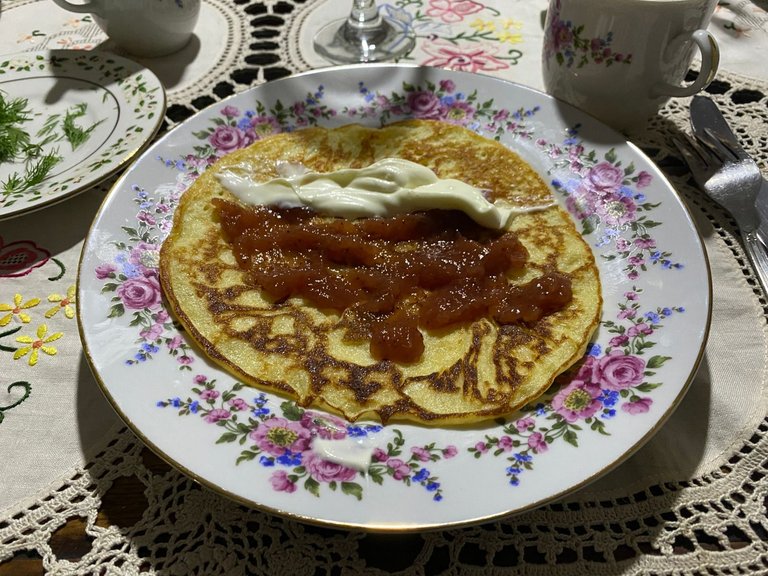
In the last recipe I shared with you, for Borsch, I mentioned one of its ingredients, smetana, and said if you wanted to tell me and I would share the recipe. So, one of the moderators of the Foodies Bee Hive community, @sirenahippie, asked to do so and here I am.
However, the formula that I found to reproduce that cream, is quite short and simple, which is why I decided to make this post about two dishes that complement each other wonderfully and have a very nice story: smetana and blini.
Smetana is a sour cream resulting from a complex process of purification and fermentation. Although it can be used in countless dishes, in Russian food, it stands out as a fundamental element in borsch (the soup I prepared in a previous post), pelmeni (a kind of Russian ravioli), pirogi (a variety of pastries) and blini, which are very similar to pancakes.
En la receta pasada que compartí con ustedes, del Borsch, mencioné uno de sus ingredientes, la smetana, y dije que si querían me lo dijeran y yo compartía la receta. Así, una de las moderadoras de la comunidad Foodies Bee Hive, @sirenahippie, me lo solicitó y aquí estoy.
Sin embargo, la fórmula que yo encontré para reproducir esa crema, es bastante corto y sencillo, razón por la cual decidí hacer este post sobre dos platos que se complementan de maravilla y que tienen una historia muy interesante: smetana y blini.
La smetana es una crema agria resultante de un proceso complejo de depuración y fermentación de la nata. Aunque puede ser usado en infinidad de platos, en la comida rusa destaca como elemento fundamental en el borsch (la sopa que preparé en un post anterior), los pelmeni, que son una especie de ravioli ruso; los pirogi, una variedad de pastelitos, y los blini que son algo muy parecido a las panquecas (panqueques, pancakes, hot cakes o tortitas, según donde vivas).
 | 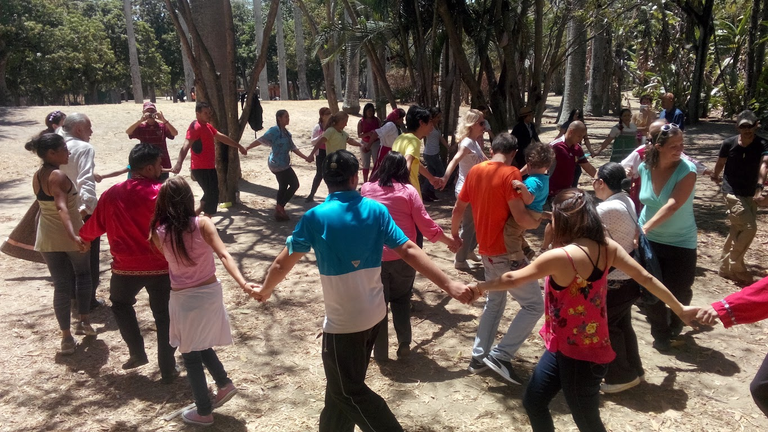 | 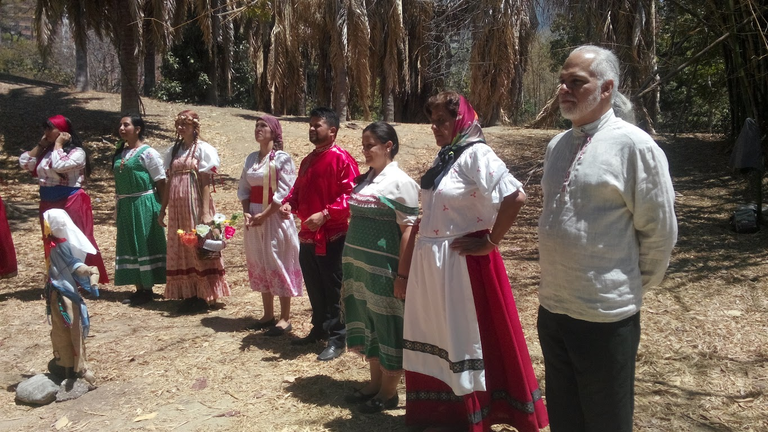 |
|---|
Maslenitza
The blini are part of the celebration of the Maslenitsa, which is a holiday of which there are records from the 2nd century (yes, century 2). The festival corresponds to the dates of the Christian carnival and celebrates the end of winter. The circular shape and the yellow color of these “cakes” represent the sun that comes to take away the winter. During these days they sing, dance, play games and prepare dishes, among which the main one is blini. On the last day of the festival, a scarecrow, symbolizing winter, is set on fire to make way for spring. It is a feast that has to do with agriculture and life cycles, that is why it is a celebration that persists throughout centuries and centuries until today.
In the Maslenitsa the blini are eaten with different types of accompaniments, where the smetana is always present, being the caviar one of the most exquisite, they also eat it with herring and other fish, pickles are a good option, as well as sweet accompaniments, such as honey.
Los blini son parte de la celebración de la Maslenitsa, que es una fiesta de la cual hay registros desde el siglo II (sí, el siglo 2). La fiesta se corresponde con las fechas del carnaval cristiano y celebran el fin del invierno. La forma circular y el color amarillo de esas "tortas" representan al sol que viene a llevarse el invierno. En esos días se canta, hacen bailes, se hacen juegos, se preparan platos, entre los cuales el principal son los blinis. El último día de la fiesta, se le prende fuego a un espantapájaros que simboliza el invierno, para así dar paso a la primavera. Es una fiesta que tiene que ver con la agricultura y los ciclos vitales, por eso es una celebración que persiste a lo largo de siglos y siglos hasta el día de hoy.
En la Maslenitsa se comen los blinis con distintos tipos de acompañamiento, donde siempre está presenta la smetana, siendo el caviar uno de los más exquisitos, también lo comen con arenque y otros pescados, los pepinillos son una buena opción, así como acompañantes dulces, como la miel.
Smetana
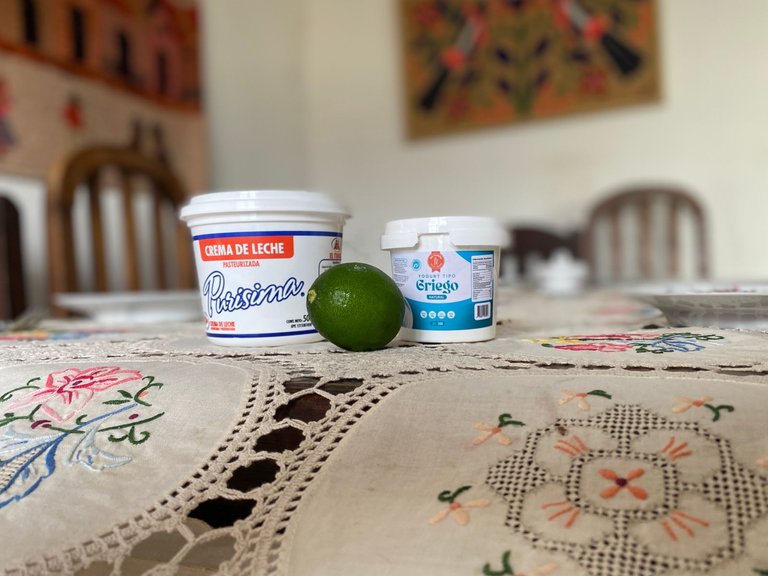
As in my house we always have many reasons to celebrate, I have to cook in large quantities. So I decided to prepare 750 ml of Smetana.
This is not the original recipe, but a way to get closer to the taste and keep a fundamental characteristic, that it does not curdle when cooked, as it is to be used in soups, cakes, etc.
In my case I used the following:
- 500 ml of milk cream. I used one with 16% fat, but the more the better.
- 250 gr. of Greek yogurt (it can be normal, but I prefer the flavor and concentration of Greek yogurt)
- The juice of half a lemon.
- Salt to taste
Preparation:
Mix the milk, cream, and yogurt well in a non-metallic container. Leave it for at least eight hours in a dry and warm place. I did it the day before and placed it in the oven turned off. Then add the lemon juice and salt. I used a teaspoon of sea salt. Stir well. Place in the refrigerator for a couple of hours before using.
Como en mi casa siempre tenemos muchas razones para celebrar, debo cocinar en grandes cantidades. Así que decidí preparar 750 ml de Smetana.
Esta no es la receta original, sino una forma de acercarnos al sabor y mantener una característica fundamental, que no cuaje al cocinarse, pues es para usarla en sopas, pasteles, etc.
En mi caso yo usé lo siguiente:
- 500 ml de crema de leche. Yo usé una con 16% de grasa, pero mientras más tenga, mejor.
- 250 gr. de yogur griego (puede ser normal, pero prefiero el sabor y concentración del griego)
- El zumo de medio limón.
- Sal al gusto
Preparación:
Mezclar bien en un recipiente que no sea metálico, la crema de leche y el yogur. Dejarlo al menos unas ocho horas en un lugar seco y cálido. Yo lo hago el día anterior y lo coloco en el horno apagado. Luego, agregar el zumo del limón y la sal. Yo usé una cucharadita de sal marina. Revolver bien. Colocar en la nevera por un par de horas antes de usarlo.
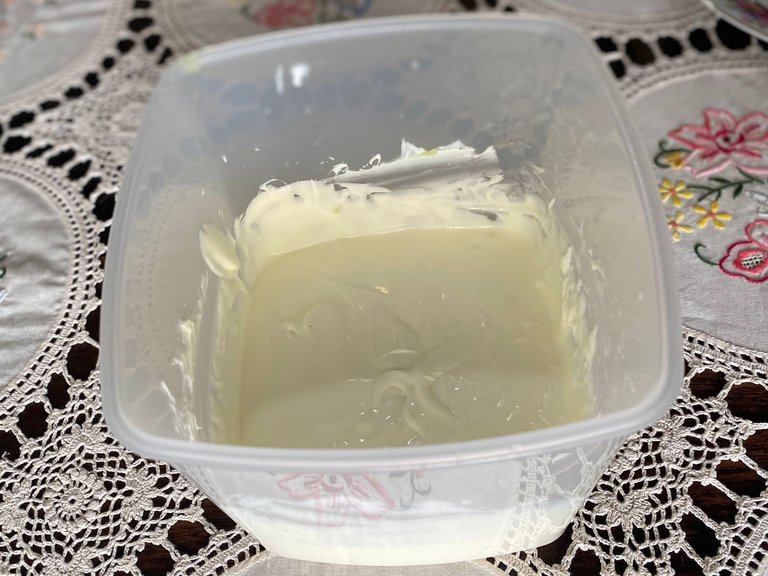
Blini
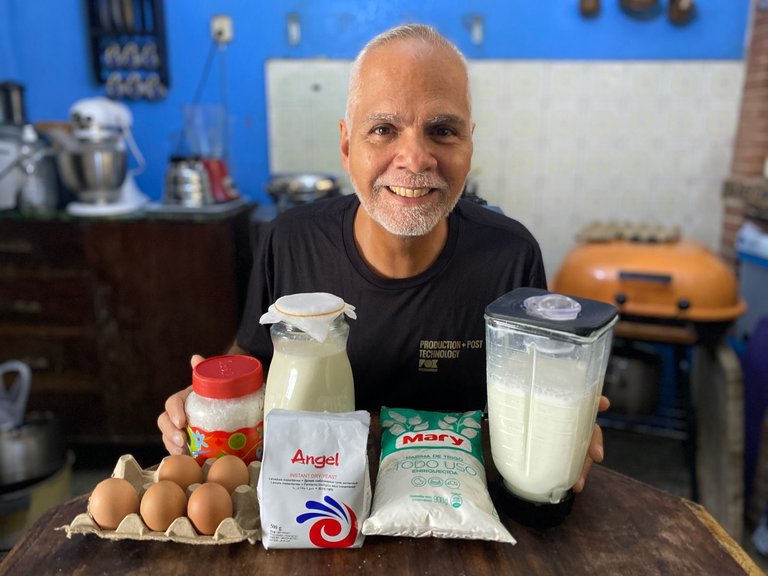
It is important to explain that in almost 20 centuries of this recipe, there are infinite varieties. As always, I have made my own selection of ingredients, according to the taste I know, what I know of Russian culture and my food criteria.
Ingredients (yields for 10 people):
- 900 gr. of flour - (can be 750 gr. + 150gr. of rye flour)
- 1 liter of warm milk
- ½ liter of kefir*. It can be replaced by smetana, cream, Greek yogurt or more milk
- 10 gr. of dry yeast or 30 gr. if fresh
- 6 tablespoons of sugar
- 6 eggs
- 3 heaping tablespoons lard or 6 tablespoons oil
* If you don't know about kefir and want to know more about this superfood, let me know in the comments and I might do a post on the subject. 😉
Es importante explicar que en casi 20 siglos de esta recete, hay infinidad de variedades. Como siempre, yo he hecho mi propia selección de ingredientes, de acuerdo al sabor que yo conozco, lo que conozco de la cultura rusa y mis criterios de alimentación.
Ingredientes (rinde para 10 personas):
- 900 gr. de harina – (pueden ser 750 gr. + 150gr. de harina de centeno)
- 1 litro de leche tibia
- ½ litro de kefir*. Puede sustituirse por smetana, crema de leche, yogur griego o más leche
- 10 gr. de levadura seca o 30 gr. si es fresca
- 6 cucharadas de azúcar
- 6 huevos
- 3 cucharadas colmadas de manteca de cochino o 6 cucharadas de aceite
* Si no conoces el kefir y quieres saber más de este super alimento, házmelo saber en los comentarios y puede ser que haga un post sobre el tema. 😉

First step:
Place the yeast in the warm milk with a tablespoon of sugar, stir, cover with a dry cloth and wait 20 minutes.
Second step:
Take that mixture and add it to the flour and stir well. Cover and let rise for one hour.
It is optional to add the kefir at this time or together with the rest of the ingredients.
Primer paso:
Colocar la levadura en la leche tibia, con una cucharada de azúcar, revolver, tapar con un paño seco y esperar 20 minutos.
Segundo paso:
Tomar esa mezcla y agregarla a la harina y revolver bien. Tapar y dejar levar por una hora.
Es opcional agregar el kefir en este momento o junto al resto de los ingredientes.
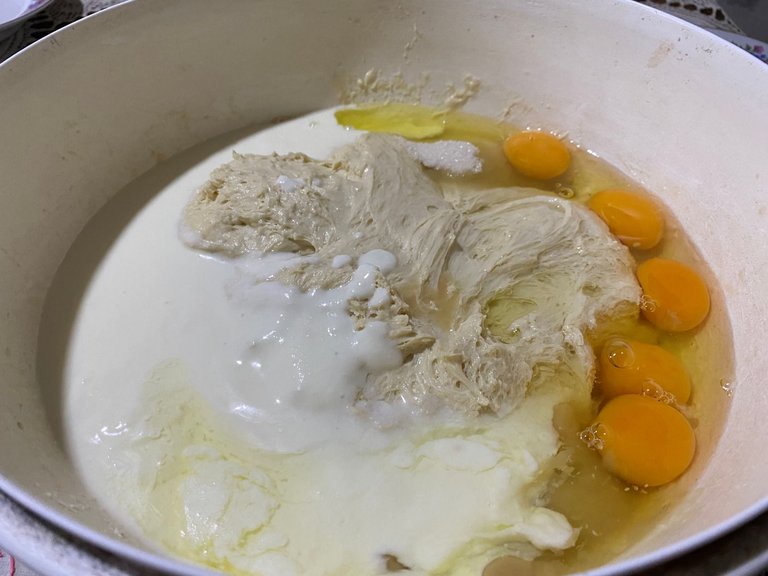
Third step:
Mix the remaining ingredients and stir well until everything is a uniform mixture.
If the mixture is too solid, you can add very hot water, until you get a liquid mixture that can be served with a ladle.
Now all that remains is to grease our pan, which I do with lard. It is usually enough to grease for the first portion, then the hot pan does not usually need more grease. Unless you notice that the mixture is starting to stick, it will not be necessary to grease again.
Tercer paso:
Mezclar los ingredientes restantes y revolver bien hasta que todo sea una mezcla uniforme.
Si la mezcla está muy sólida, puedes agregar agua bien caliente, hasta lograr una mezcla líquida que se pueda servir con cucharón.
Ahora solo queda engrasar nuestra sartén, lo cual yo hago con manteca de cochino. Por lo general basta con engrasar para la primera porción, luego la sartén caliente no suele necesitar más grasa. A menos que percibas que se está empezando a pegar la mezcla, no será necesario engrasar de nuevo.
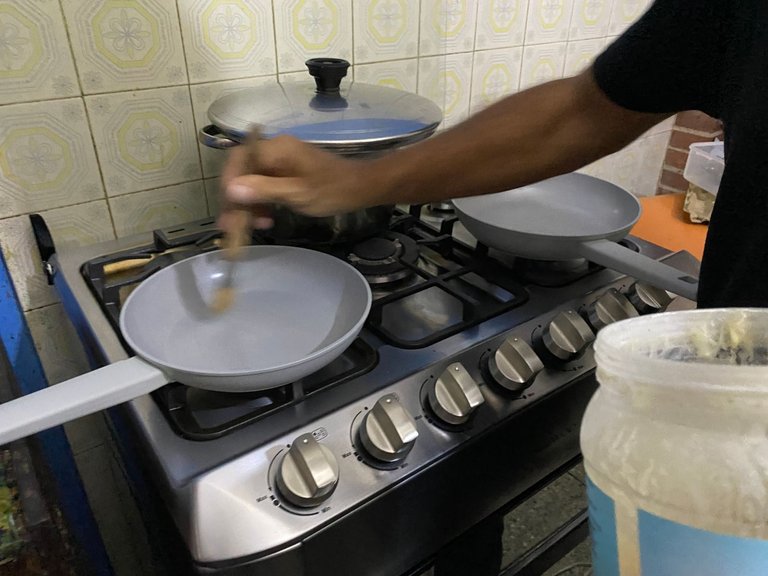 | 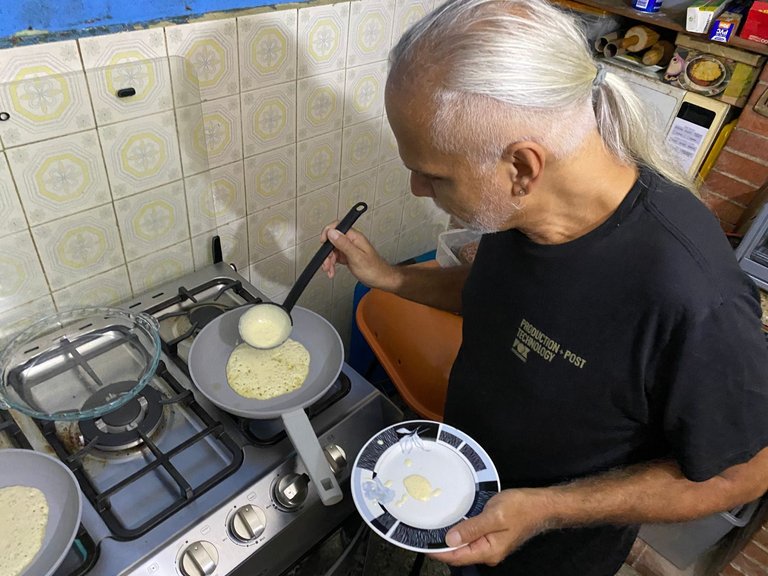 |
|---|---|
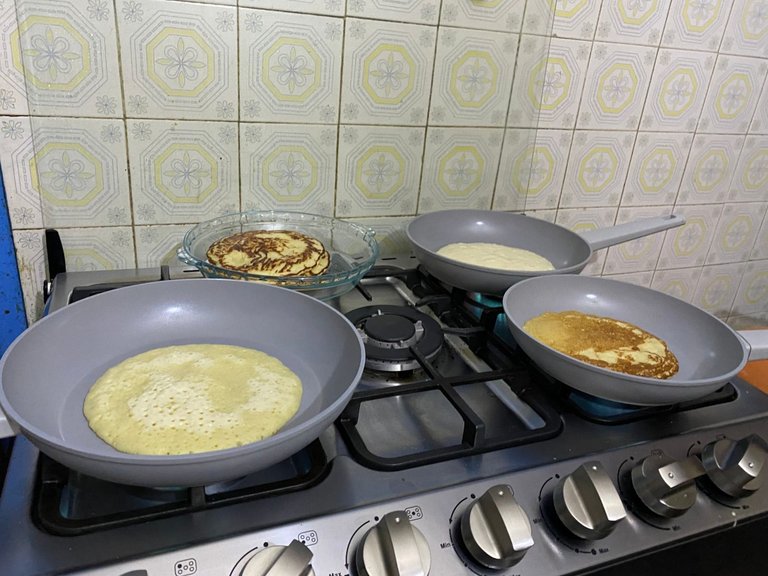 | 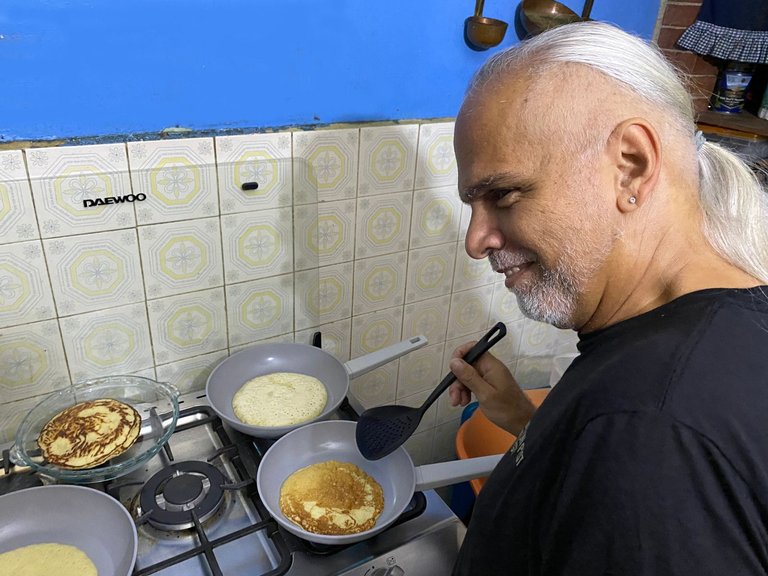 |
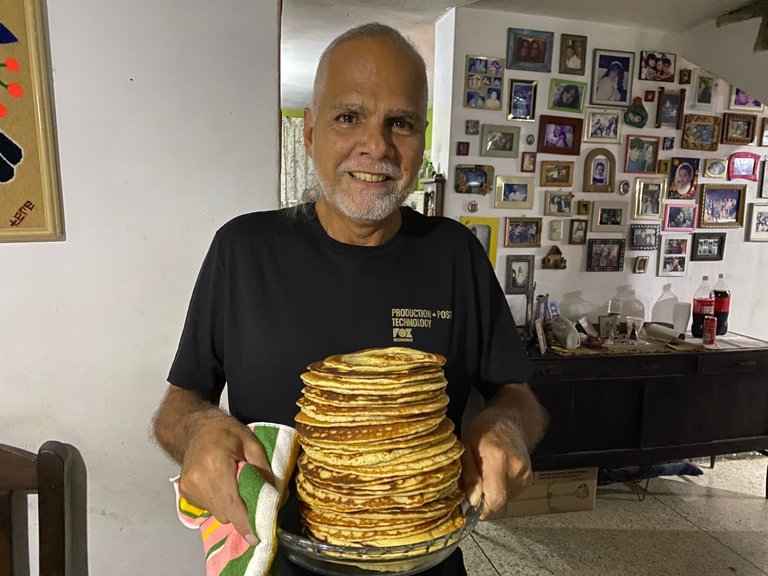
On this occasion, 33 blinis were made from this mixture.
As accompaniments to the dish we had, of course, smetana, cheese, cucumbers, jam and dill leaves, which are very typical in Russian gastronomy and give a special touch to the dishes.
It is very common to drink tea as part of the celebration. We had a hibiscus flower tea, but in the Arabian style (to change things up a bit).
But as we were celebrating the achievements of one of my sons and the visit of an aunt, we also served red wine and it was very good.
En esta oportunidad salieron 33 blinis de esa mezcla.
Como acompañantes del plato tuvimos, por supuesto, la smetana, queso, pepinos, mermelada y hojas de eneldo, que son muy típicas en la gastronomía rusa y que le dan un toque especial a los platos.
Es muy común tomar té, como parte de la celebración. Nosotros tuvimos uno de flor de jamaica, pero al estilo árabe (para varia un poco la cosa).
Pero como estábamos de celebración por logros de uno de mis hijos y por la visita de una tía, servimos también vino tinto y le quedó muy bien.
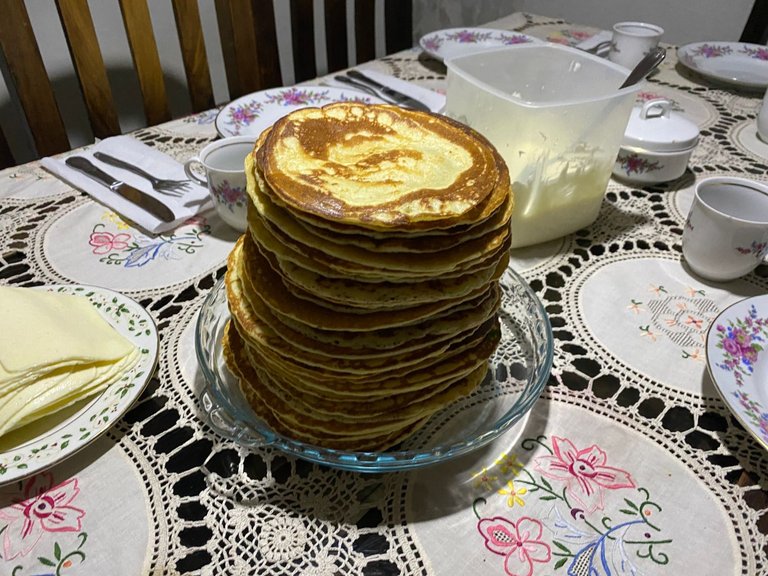 | 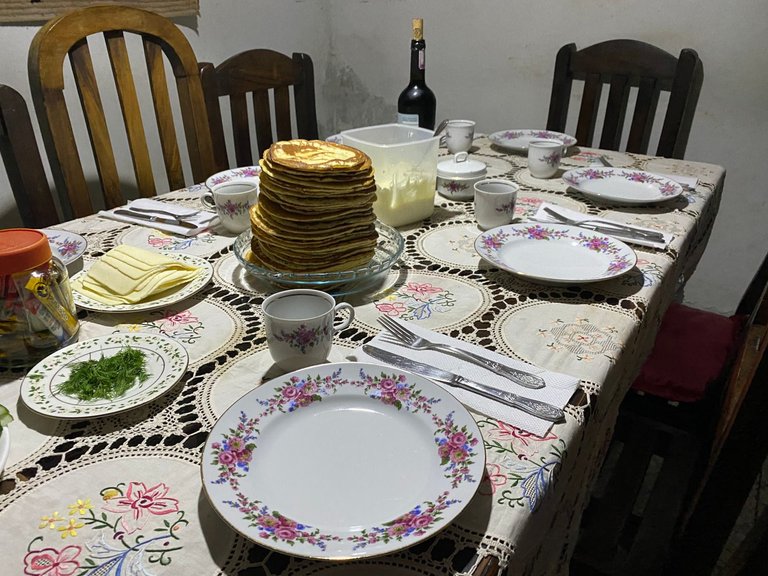 |
|---|---|
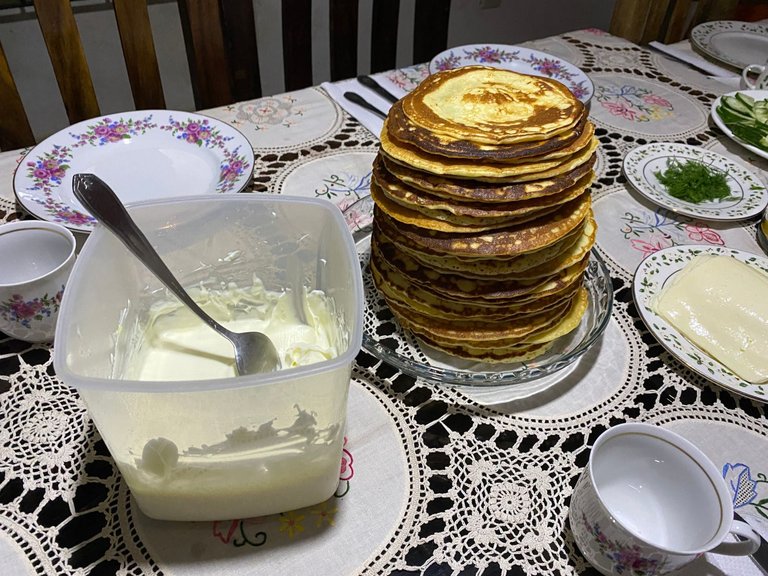 |  |


 Vote la-colmena for witness / By @Ylich |
|---|
http://ylich.com
https://sptfy.com/ylich
Posted Using INLEO


